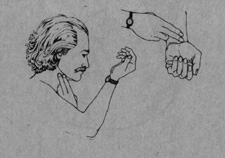At either temple (the temporal pulse).
Right over your heart (the apical pulse).
Using whichever place works best for you, practice counting your heartbeats. Once you have a good feel for it, count your pulse for thirty seconds and multiply by two. This—assuming that you're now

feeling fairly relaxed and rested—is your resting (as opposed to your exercising) pulse. Most people have a resting pulse between 50 and 90. If you do not get much exercise now, you could reduce your resting pulse substantially by starting a gentle exercise program. Three years ago, before I started running and walking regularly, my resting pulse was 72. At the moment, let's see . . . it's 47.
Me and the Marathon
I should tell you that I myself didn't follow the advice I'm giving you. I suggest starting slowly. I started fast—and suffered many setbacks as a result.
I decided from the beginning that my goal was going to be to run a marathon. In retrospect, I see that I picked an achievement instead of a process as a goal.
I did run a marathon. I trained up to two hours a day to prepare for it and enjoyed it immensely.
I may very well run another some day, but for now, a half-hour run each morning and an occasional walk in the evening seem just right. My present exercise is much more integrated into the rest of my day. I don't push myself as I once did. And unlike some of my earlier experiences with exercise, I inevitably come back feeling better than when I started.
My biggest problem when I started running was that I was simply unable to run slowly enough. I'd find myself out there on the track or trail driving myself farther and faster than I wanted to go. I hadn't learned about measuring my pulse yet. My exercise experiences were sufficiently unpleasant that I found myself skipping days at a time. Then I'd really feel guilty.
Gradually I realized that many of my attitudes toward exercise had their origins in high school P.E. classes, where laps were assigned as punishment, and we were given our term grades on the basis of how quickly we could run the mile—seven minutes was an A, eight was a B. nine a C, and so on. These experiences had taught me to hate running, to hate exercise, and, when I was forced into it, to push myself to get it over with as soon as possible.
Teddy Bear
My difficulties in running brought back memories of those P.E. classes and of one of my high school classmates, a gentle, ungainly fat boy we nicknamed Teddy Bear.
On each forced run, Teddy Bear would be found far to the rear of the pack, plodding patiently away. Long after the rest of us had finished and thrown ourselves down, sweaty and panting on the grass, Teddy Bear would still be pounding slowly around the track. He would come across the finish line much less out of breath than we had been. He knew his limits.
The hardest thing in my early months of running was getting in touch with the Teddy Bear in myself—a slow, awkward, ridiculous plodder. I'd been a fast runner as a child, and even at the age of thirty-three it was difficult for me to give up my self-image as a fast runner. The Teddy Bear in myself was a part I'd never learned to think very highly of. I think much more highly of it now. Teddy Bear had the right idea all along.
I thought of myself as a hare, not a tortoise. I had such a psychological investment in being fast that I was pushing myself as though getting in good shape were no more than a matter of will power. If you're going to run you run, right?